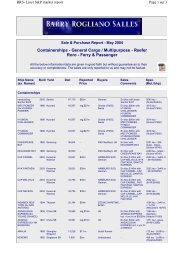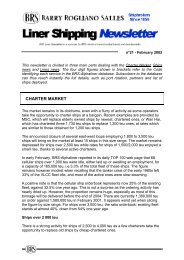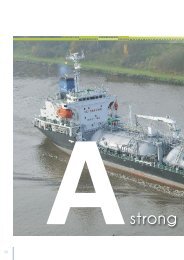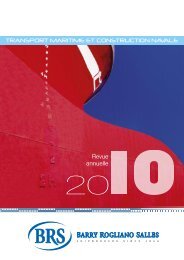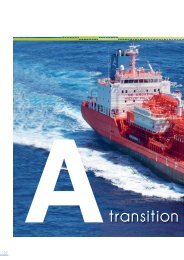RA BRS 2003 GB >pdf
RA BRS 2003 GB >pdf
RA BRS 2003 GB >pdf
You also want an ePaper? Increase the reach of your titles
YUMPU automatically turns print PDFs into web optimized ePapers that Google loves.
46<br />
dwt<br />
600,000<br />
500,000<br />
400,000<br />
300,000<br />
200,000<br />
100,000<br />
Shipping and Shipbuilding Markets <strong>2003</strong><br />
0<br />
delivered in 2002<br />
The North European market remained at healthy<br />
levels with freight rates improving by about 10 %<br />
at the beginning of the year. Then following a<br />
good volume of contractual nominations, freights<br />
fluctuated around previous levels up until the third<br />
quarter, to finally rise significantly at the end of the<br />
year thanks to a very sustained spot market.<br />
The Mediterranean trade is still divided in two,<br />
based on the age of vessels and the approvals<br />
required by the main charterers. Consequently<br />
there is a two-tiered market, which basically<br />
stayed steady over the whole year.<br />
On the other zones of trade, from the Mediterranean<br />
to North Europe and back, rates had mixed<br />
fortunes. For North Europe the supply of carriers is<br />
becoming progressively reduced, following a fear<br />
by certain owners of tighter controls and multiple<br />
inspections by authorities in the main ports.<br />
Consequently on this traffic, charterers faced a<br />
shortage of supply and variations in freight rates<br />
from 10 to 20 % within two to three months, with<br />
peaks in the spring and the end of the year, whereas<br />
the rest of 2002 was relatively stable.<br />
Spot Mediterranean bound movements remained<br />
at slightly lower levels with the main volume of<br />
business being covered under term contracts.<br />
Renewal of contracts for <strong>2003</strong> were mostly made<br />
at unchanged levels to 2002 or else very similar,<br />
with some obtaining a modest increase of about<br />
5%.<br />
Chemical carriers on order as at January 1, <strong>2003</strong><br />
(in deadweight)<br />
<strong>2003</strong><br />
2004<br />
3,500-6,000 dwt<br />
6,000-10,000 dwt<br />
10,000-20,000 dwt<br />
Over 20,000 dwt<br />
2005<br />
It is necessary to adjust these rates on European<br />
movements as owners pay today for their bunkers<br />
at much higher prices and some are suffering from<br />
the dollar devaluation against the euro as numerous<br />
freight contracts are based in dollars.<br />
Long distance movements<br />
On the U.S. / Europe traffic, the market suddenly<br />
took off at the beginning of March, to peak in<br />
April. Significant movements of styrene and cumene<br />
were fixed by producers and traders following<br />
some technical shutdowns in Europe. As a result<br />
rates for lots of 2,000 tons went from $ 35 to $ 45<br />
per ton. Thereafter freights experienced a steady<br />
drop with rates finding levels as at the end of<br />
2001.<br />
On westbound Atlantic trade, the market firmed<br />
up as from the beginning of the second quarter,<br />
then experienced a peak during the summer with<br />
a falling off down to $ 40 per ton for 2,000 ton<br />
lots, to finally finish the year with a 15 % increase.<br />
The main spot movements out of Europe were with<br />
cargoes of methanol, MTBE and sulphuric acid.<br />
Movements from Europe to Asia were largely term<br />
contracts, with steady volumes in the hands of the<br />
four main chemical owners. Spot freight rates for<br />
1,000 tons of chemical products remained at<br />
about $60 per from the Rotterdam area to main<br />
Asian ports, with the same for 2,000 ton lots,<br />
which increased in the summer and improved progressively<br />
to $ 50 to $ 60 per ton.



